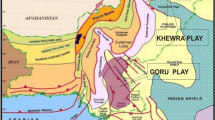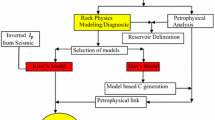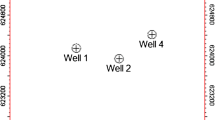Abstract
A dozen of inversion methods are applied and tested to estimate the permeability of the area where gas-fingering event has taken place in an Iranian carbonate reservoir located southwest of Iran. In a previous work, the gas-fingering event was detected by inverting the 3D seismic data and in this study the permeability model in that area is estimated. Because the lateral area of the gas-fingering event is narrow, the whole system conducting the injected gas can be considered as one rock unit system and therefore the assumption of horizontal linear steady-state flow can be applied. Inversion methods are exploited to determine the permeability in the interval of interest. The interval of interest is located at the crest and involves four wells among which one is the gas-injection well. To investigate the feasibility of such an approach and select the best possible inversion method, first a controlled experiment for the system is designed and studied. The porosity values of the system are known from seismic data inversion and the permeability values are the desired parameters. The permeability values at well locations are known via well-test data and are used as constraints in the inversion procedure. The interval of interest is discretized and a simulator is used to simulate the fluid flow in the controlled system in order to apply and validate the inversion methods. All calculations are performed in the MATLAB environment. According to the results from the controlled experiment, the Maximum Entropy and Total Variation methods were found to be the best two inversion methods which were successful in retrieving the true permeability model. Similar comparative study using different inversion methods is performed for the real case for which the results retrieved by the Total Variation method is most reliable as it suggests the best recovery of the permeability value for the check-well. An estimation of the fracture permeabilities for the area under study also indicated that the inverted permeability values are most representing the fracture permeabilities rather than the matrix. The results of this study will be used to tune the field simulation model in terms of rock and fluid properties, consider the inverted permeability model as further constraints for the reservoir history-matching of the oil field, reconsider the factors involving the gas injection plan for the oil field, and obtain insights for further field development plans in other nearby oil fields.












available at each cell











Similar content being viewed by others
References
Aanonsen SI, Tveit S, Alerini M (2019) Using Bayesian Model Probability for Ranking Different Prior Scenarios in Reservoir History Matching, SPE-194505-PA, SPE Journal, 24(4). https://doi.org/https://doi.org/10.2118/194505-PA.
Aster RC, Borchers B, Thurber CH (2005) Parameter estimation and inverse problems. Elsevier, Boston
Caers J, Hoffman T (2006) The probability perturbation method: a new look at Bayesian inverse modeling. Math Geol 38(1):81–100
Chakra NC, Saraf DN (2016) History matching of petroleum reservoirs employing adaptive genetic algorithm. J Pet Explor Prod Technol 6(4):653–674
Chen Y, Oliver DS (2013) Levenberg–Marquardt forms of the iterative ensemble smoother for efficient history matching and uncertainty quantification. Comput Geosci 17:689–703. https://doi.org/10.1007/s10596-013-9351-5
Cominelli A, Ferdinandi F, de Montleau PC, Rossi R (2007) Using gradients to refine parameterization in field-case history-matching projects. SPE Reserv Evalu Eng 10(3):233–240
dos Santos Amorim EP, Goldfeld P, Dickstein F, dos Santos RW, Xavier CR (2010) Automatic History Matching in Petroleum Reservoirs Using the TSVD Method. In: Taniar, D., Gervasi, O., Murgante, B., Pardede, E., Apduhan, B.O. (eds.) ICCSA 2010. LNCS, vol. 6017, pp. 475–487. Springer, Heidelberg.
Efendiev Y, Hou T, Luo W (2006) Preconditioning Markov chain Monte Carlo simulations using coarse-scale models. SIAM J Sci Comput 28(2):776–803
Emerick AA, Reynolds AC (2011) History matching a field case using the ensemble kalman filter with covariance localization. SPE Res Eval Eng 14(4):443–452. https://doi.org/10.2118/141216-PA
Ertekin T, Abou-Kassem JH, King GR. Basic Applied Reservoir Simulation, SPE Textbook Series, Vol. 7.
Evensen G. (2009) Data Assimilation the Ensemble Kalman Filter, Springer-Verlag Berlin Heidelberg, 2nd edition, https://doi.org/10.1007/978-3-642-03711-5.
Eydinov D, Aanonsen SI, Haukas J, Aavatsmark I (2008) A method for automatic history matching of a compositional reservoir simulator with multipoint flux approximation. Comput Geosci 12(2):209–225
Gao G, Vink JC, Chen C, El Khamra Y, Tarrahi MA (2017a) Distributed gauss-newton method for history matching problems with multiple best matches. Comput Geosci 21(5–6):1325–1342. https://doi.org/10.1007/s10596-017-9657-9
Gao G, Jiang H, Hagen PV, Vink J, Wells T (2017) A Gauss–Newton Trust Region Solver for Large-Scale History Matching Problems, Presented at the SPE Reservoir Simulation Conference, Montgomery, Texas, SPE-182602-MS. https://doi.org/https://doi.org/10.2118/182602-MS.
González-Rodríguez P, Kindelan M, Moscoso M, Dorn O (2005) History matching problem in reservoir engineering using the propagation-backpropagation method. Inverse Probl 21:565–590
Hosseini M, Riahi MA (2019) Using input-adaptive dictionaries trained by the method of optimal directions to estimate the permeability model of a reservoir. J Appl Geophys 165:16–28. https://doi.org/10.1016/j.jappgeo.2019.04.006
Hosseini M, Riahi MA (2019) Detecting a gas injection front using a 3D seismic data: case of an Asmari carbonate reservoir in the Zagros basin. Carbonates Evaporites 34:1657–1668. https://doi.org/10.1007/s13146-019-00514-2
Jo H, Jung H, Ahn J, Lee K, Choe J (2017) History matching of channel reservoirs using ensemble Kalman filter with continuous update of channel information. Energy Explor Exploit 35(1):3–23
Kazemi A, Stephen KD (2013) Optimal parameter updating in assisted history matching using streamlines as a guide. Oil Gas Sci Technol 68(3):577–594. https://doi.org/10.2516/ogst/2012071
Kazemi A, Stephen KD (2012) Schemes for automatic history matching of reservoir modeling: a case of nelson oilfield in UK. Petrol Explor Dev 39(3):349–361. https://doi.org/10.1016/S1876-3804(12)60051-2
Kreyszig E (2017) Advanced Engineering Mathematics, 10th edition, Wiley publication.
Li R, Reynolds AC, Oliver DS (2003) Sensitivity coefficients for three-phase flow history matching. J Can Pet Technol 42(4):70–77
Liao Q, Zeng L, Chang H, Zhang D (2019) Efficient History Matching Using the Markov-Chain Monte Carlo Method by Means of the Transformed Adaptive Stochastic Collocation Method, SPE-194488-PA, SPE Journal, Volume 24, Issue 04, https://doi.org/https://doi.org/10.2118/194488-PA.
Mariethoz M, Caers J (2014) Multiple-point geostatistics: stochastic modeling with training images. John Wiley and Sons Ltd. https://doi.org/10.1002/9781118662953
Maschio C, Schiozer DJ (2008) A New Methodology for assisted history matching using independent objective functions. Pet Sci Technol 26(9):1047–1062. https://doi.org/10.1080/10916460701208389
Olalotiti-Lawal F, Datta-Gupta A (2018) A multiobjective markov chain monte carlo approach for history matching and uncertainty quantification. J Pet Sci Eng 166(July):759–777. https://doi.org/10.1016/j.petrol.2018.03.062
Oliver DS, Reynolds AC, Liu N (2008) Inverse theory for petroleum reservoir characterization and history matching, 1st editon. Cambridge University Press, Cambridge
Onwuchekwa C, Dennar L, Ahmed S, Bakare O, and Emelle C (2017) Adjoint-Based Assisted History Matching: A Niger Delta Field Case Study. Paper SPE-189155-MS presented at the SPE Nigeria Annual International Conference and Exhibition held in Lagos, Nigeria, 31 July – 2 August.
Oyerinde A, Datta-Gupta A, Milliken W (2009) Experiences with streamline-based three-phase history matching. SPE 109964, SPE Reserv. Evalu. Eng. 12(4), 528–541.
Peaceman DW (1983) Interpretation of well-block pressures in numerical reservoir simulation with non-square grid blocks and anisotropic permeability, SPE. Trans AIME 275:10–22
Quarteroni A, Sacco R, Saleri F (2007) Numerical mathematics, 2nd edn. Springer-Verlag, Berlin Heidelberg
Raghu A, Yang X, Khare S, Prakash J, Huang B, Prasad V (2017) Reservoir history matching using constrained ensemble Kalman filtering. Can J Chem Eng. https://doi.org/10.1002/cjce.22965
Rodrigues JRP (2006) Calculating derivatives for automatic history matching. Comput Geosci 10(1):119–136
Romary T (2009) Integrating production data under uncertainty by parallel interacting Markov chains on a reduced dimensional space. Comput Geosci 13(1):103–122
Romero CE, Carter JN (2001) Using genetic algorithms for reservoir characterisation. J Pet Sci Eng 31(2–4):113–123
Stenerud VR, Kippe V, Lie KA, Datta-Gupta A (2008) Adaptive multiscale streamline simulation and inversion for high-resolution geomodels. SPE J 13(1):99–111
Zhang X, Awotunde AA (2016) Improvement of Levenberg-Marquardt algorithm during history fitting for reservoir simulation. Pet Explor Dev 43(5):876–885. https://doi.org/10.1016/S1876-3804(16)30105-7
Acknowledgement
This study did not receive fund from any institution or non-for-profit organizations. It is designed and experimented by the author; however, he would like to thank the Geology and Geophysics department of the National Iranian South Oil Company and also the Reservoir Engineering department of the same oil company.
Author information
Authors and Affiliations
Corresponding author
Ethics declarations
Conflict of interest
The author declares no conflict of interest.
Additional information
Communicated by Michal Malinowski (CO-EDITOR-IN-CHIEF)/Liang Xiao (ASSOCIATE EDITOR).
Rights and permissions
About this article
Cite this article
Hosseini, M. Using total variation method to estimate the permeability model of a gas-fingering area in an Iranian carbonate reservoir. Acta Geophys. 69, 821–839 (2021). https://doi.org/10.1007/s11600-021-00573-x
Received:
Accepted:
Published:
Issue Date:
DOI: https://doi.org/10.1007/s11600-021-00573-x




